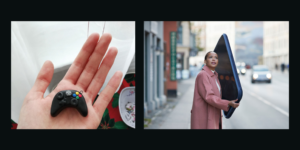Hello and welcome! Ever wondered what life might feel like if the world wasn’t built with you in mind? Picture it: everyday things—the things that make life easier, more enjoyable, even safer—just aren’t designed for you. It’s a strange thought, isn’t it?
Let’s try a little game.
The inconvenience Challenge

Imagine this: You’ve had a long day and finally settle down for some well-deserved gaming. But as you grab your controller, you realize it’s too big, like it was designed for someone else—someone with much larger hands. Every button press is awkward, and instead of relaxing, you’re wrestling with the controller, struggling just to make it work. Frustrating, right?
Or think about your phone—one you rely on constantly—but this one is too small for your hand. Just texting feels awkward and clumsy, a simple task turned difficult.
Now picture getting into a car. The seatbelt presses against your neck, the pedals feel too far, and you have to strain just to reach the steering wheel. Every drive feels like a constant adjustment, to something clearly meant for someone else.
We’re pretty sure you get where we’re going with these examples. They may seem hypothetical, but for millions of women, they’re a daily reality. They navigate a world designed for someone else’s size, shape, and needs—often without even realizing the degree of discomfort or risk.
Let’s take a step further and look at a few real-life scenarios that reveal just how deeply design affects our daily lives.
Built for Men, Not Women

Safety
Car safety features—seatbelts, airbags, even crash test dummies—are based on the “average” male body: roughly 5’9” and 172 pounds. But women’s bodies are different. Studies show that, compared to men, women are 73% more likely to be seriously injured and 17% more likely to die in a car crash. Why? Because the safety features don’t fit or consider their size. Crash testing hasn’t accounted for the unique ways women’s bodies respond during a crash—different muscle mass, smaller frames, and distinct body composition mean that what’s “safe” for men often isn’t for women. So, the next time you’re out shopping for a car for any woman, why not: #AskTheQuestion: Has this safety feature been tested with women in mind?

Healthcare
When it comes to healthcare, the gaps get even more concerning. For decades, medical research and drug testing were done almost exclusively on men. Until 1993, women were routinely excluded from clinical trials. Today, women are still underrepresented: they make up only 25% of participants in cardiovascular drug studies, despite being at risk for heart disease.
Here’s what that means in real terms: women are 50% more likely to be misdiagnosed with heart disease. Their symptoms often look different than men’s—shortness of breath, nausea, back pain rather than chest pain—yet diagnostic criteria are based on male symptoms. It can lead to missed or delayed treatment, with potentially life-threatening consequences.
And this isn’t the only example. Take Ambien, a common sleep aid. Only in 2013 did the FDA recommend cutting the dosage for women after discovering that women metabolize the drug more slowly, leading to impaired driving and increased risk of accidents.
Women experience up to 1.7 times more adverse drug reactions than men. Differences in body composition, hormones, metabolism, and more all contribute, yet too many drugs are still dosed and designed with only men in mind.
And this is but just the tip of the iceberg. There are so many invisibly unfair situations that women face in today’s world that most women aren’t even aware of it.
So next time, when it’s about health, remember to #AskTheQuestion: Has this treatment been tested for women’s unique needs?
What Can We Do?

The male default in design isn’t usually intentional; it’s a result of centuries-old habits in industries traditionally led by men. But now that we know better, we can do better—starting with asking the right questions. Questions that can eventually change the way we all experience the world.
Here’s how we can start:
See the Gaps:
Being here, reading this article is a powerful first step. Awareness opens the door to change.
Acknowledge the Gaps:
Recognize that there is a gap in how men’s and women’s experiences are considered. Acknowledging this difference means understanding that something can and should be done about it.
Address the Gaps:
Talk to the Women in Your Life. Ask about their day-to-day experiences—the little inconveniences they’ve learned to overlook. You might be surprised by what you hear, and your questions may even spark new insights for them, too.
Challenge What’s “Normal”:
Speak up, ask questions, and advocate for the women in your life.
#AskTheQuestion when it matters. Ask if safety tests, healthcare treatments, and everyday tools were designed for everyone, not just men.
Every question and conversation opens a small window into a world that could be better. Change begins by seeing the gaps, talking openly, and one day, transforming what’s possible for everyone.
#LetsGetCloser, together.






